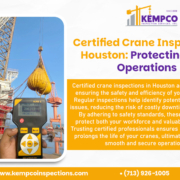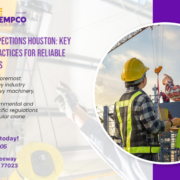Certified Crane Inspections Houston: Protecting Your Operations
In the dynamic industries of construction, manufacturing, and shipping, cranes play an indispensable role. These powerful machines lift, move, and position heavy materials, ensuring efficient operations across Houston’s bustling industrial landscape.
However, with great utility comes great responsibility. Regular certified Crane Inspections Houston are crucial for maintaining safety, ensuring compliance, and protecting your operations from costly disruptions.
Why Certified Crane Inspections Matter
Cranes are complex pieces of machinery that operate under high stress and demanding conditions. Over time, wear and tear can compromise their integrity, creating potential hazards for workers and property. Certified crane inspections are designed to:
Ensure Safety: Regular inspections identify potential risks and defects, preventing accidents and ensuring a safe working environment.
Maintain Compliance: In Houston, strict regulations govern crane operations. Certified inspections ensure compliance with OSHA standards and local safety requirements.
Prevent Downtime: Detecting and addressing issues early prevents unexpected breakdowns, keeping your operations running smoothly.
Protect Investments: Cranes are significant investments. Inspections extend their lifespan, ensuring maximum return on investment.
What to Expect During a Certified Crane Inspection
Certified crane inspections are thorough and systematic. These evaluations typically include:
Visual Inspections: Inspectors examine structural components, such as hooks, chains, ropes, and welds, for signs of wear, deformation, or cracks.
Operational Testing: Load-bearing mechanisms and safety systems are tested to ensure they function correctly under real-world conditions.
Electrical and Mechanical Checks: Electrical systems, brakes, gears, and hydraulic components are assessed for proper operation and compliance with safety standards.
Documentation Review: Maintenance logs, repair histories, and usage records are reviewed to ensure consistent upkeep and compliance with regulatory requirements.
At the conclusion of the inspection, you’ll receive a detailed report outlining any findings, recommendations for repairs, and a timeline for re-inspection. This documentation is essential for regulatory compliance and provides a roadmap for maintaining optimal crane performance.
Common Issues Found During Inspections
Certified crane inspections often uncover problems that, if left unaddressed, could lead to significant issues. Common findings include:
Worn Out Wire Ropes: Over time, wire ropes can fray or corrode, reducing their load-bearing capacity.
Cracked Hooks: Even minor cracks in hooks can lead to catastrophic failure under heavy loads.
Electrical Failures: Faulty wiring, blown fuses, or malfunctioning control panels can disrupt operations and pose safety risks.
Misaligned Components: Misalignment of gears, pulleys, or tracks can strain the crane’s mechanisms, leading to faster wear and tear.
Benefits of Partnering with Certified Inspectors in Houston
Houston’s industrial sector demands high standards, and partnering with certified crane inspectors offers numerous benefits:
Expertise You Can Trust: Certified inspectors are trained to identify even the most subtle signs of wear or potential failure, providing peace of mind.
Improved Operational Efficiency: By addressing issues proactively, inspections reduce the risk of unscheduled downtime and costly repairs.
Regulatory Confidence: Compliance with OSHA and local regulations protects your business from fines and legal liabilities.
Customized Solutions: Many inspection providers in Houston offer tailored maintenance plans based on your equipment’s specific needs.
A Proactive Approach to Crane Safety
Beyond regular inspections, adopting a proactive approach to crane safety can significantly enhance operational reliability. Consider the following best practices:
Routine Maintenance: Schedule regular maintenance checks to complement certified inspections.
Employee Training: Train operators and maintenance personnel to recognize early warning signs of mechanical issues.
Utilize Technology: Invest in monitoring systems that provide real-time data on crane performance and potential issues.
The Bottom Line
Certified crane inspections are more than a regulatory requirement; they are a critical component of operational excellence in Houston’s industrial sectors. By ensuring safety, compliance, and efficiency, these inspections protect your workforce, assets, and reputation.
Don’t wait for a costly breakdown or accident to highlight the importance of crane inspections. Partner with Kempco Inspection Services, Inc. trusted certified Crane Inspections Houston provider today and take the first step toward safeguarding your operations and ensuring long-term success.




